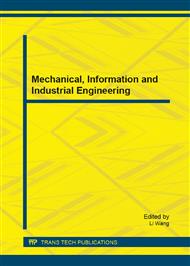[1]
Kexiang L., Jie Q., Ruike Y in: Image Analysis and Signal Processing. pp.223-227(2010).
Google Scholar
[2]
Avishek Saha, Jayanta Mukherjee, hamik Sural in: Signal Processing Image Communication. 26(9), pp.438-454(2011).
Google Scholar
[3]
Zhiqiang Zhao, Ying Chen in: Opto-Electronic Engineering (In Chinese). 38(6): 146-150, (2011).
Google Scholar
[4]
Lidong Xu, Xinggang L in: IEEE Trans. on Consumer Electronic. 52(2), pp.566-574(2006).
DOI: 10.1109/tce.2006.1649681
Google Scholar
[5]
Guodong Zhang, Mingquan Wang, Dong Guo in: Microelectronics & computer (In Chinese). 27(10), pp.53-56(2010).
Google Scholar
[6]
Yunguang Qi, Gang An, Zhengbo Gong in: Computer Engineering (In Chinese). 36(6), pp.230-232(2012).
Google Scholar
[7]
Junbo Wang, Xing-fu Sun, Lei Zhu in: Computer Development & Application (In Chinese). 25(9), pp.21-26(2012).
Google Scholar
[8]
Xuehai Gu, Li-ping Wang in: Applied Optics (In Chinese). 34(6), pp.957-963(2013).
Google Scholar
[9]
Kuglin C D, Hines D C in: IEEE Conference on Cybernetics. pp.163-165(1975).
Google Scholar
[10]
Hui Xing, Jinglong Yan in: Opto-electronic Engineering (In Chinese). 34(3), pp.37-41(2007).
Google Scholar
[11]
Harris C, Stephens M. edited in Proceeding of 4th Alvey Vision Conference. pp.147-151(1998).
Google Scholar
[12]
SMITH S M, BRADY M in: Journal of Computer Vision. 23(1), pp.45-78(1997).
Google Scholar
[13]
Peng Yan, Ru An in: Infrared and Laser Engineering (In Chinese). 38(6), pp.1104-1108(2009).
Google Scholar
[14]
LOWER D edited in International Journal of Computer Vision. 60(2), pp.91-110(2004).
Google Scholar
[15]
Herbert Bay, Andreas Ess in: Computer Vision and Image Understanding. 110(3), p.346–359(2008).
Google Scholar
[16]
Fischler M A, Bolles R C in: Communications of the ACM. 24(6), pp.381-395(1981).
Google Scholar
[17]
M K Gullu, E Yaman, S Erturk in: Electronics Letters. 39(5), pp.429-431(2003).
Google Scholar
[18]
R L Kirlin, A Monghaddamjoo in: IEEE Transaction on Acoustics. 34(2), pp.252-263(1986).
Google Scholar
[19]
Chuan Ge in: Xian: Xidian University (In Chinese). (2011).
Google Scholar
[20]
Jing Zhou, Xiangao Huang in: Instrumentation customer. 16(3), pp.71-73(2009).
Google Scholar
[21]
YAO J., J. Xiaoyu in: Optics and precision engineering. 17(5), pp.1105-1110, (2009).
Google Scholar
[22]
Yasuyuki Matsushita in: IEEE Transactions on Pattern Analysis and Machine Intelligence. 2005(1), pp.50-57.
Google Scholar
[23]
Yuhong Liu in: National University of Defense Technology (In Chinese). (2007).
Google Scholar
[24]
Gaojie Liu, Guohua Zhang in: Electronic Optics & control (In Chinese). 18(3)(2011).
Google Scholar
[25]
Yuefei Zhang in: Chengdu: University of electronic science and technology of china (In Chinese), (2011).
Google Scholar
[26]
Matti Niskanen, Olli Silven edited in: ICME. pp.405-408, (2006).
Google Scholar


